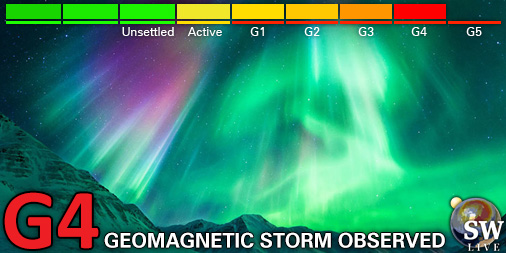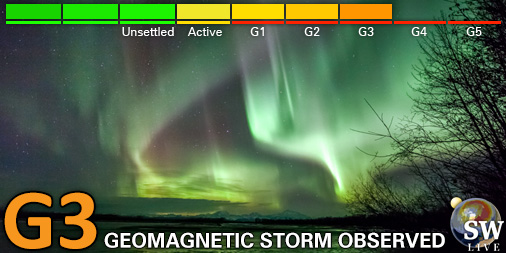Viewing archive of Monday, 26 January 2004
Solar activity report
Any mentioned solar flare in this report has a scaling factor applied by the Space Weather Prediction Center (SWPC). Because of the SWPC scaling factor, solar flares are reported as 42% smaller than for the science quality data. The scaling factor has been removed from our archived solar flare data to reflect the true physical units.
Report of Solar-Geophysical Activity 2004 Jan 26 2200 UTCPrepared by the NOAA © SWPC and processed by SpaceWeatherLive.com
Joint USAF/NOAA Report of Solar and Geophysical Activity
SDF Number 026 Issued at 2200Z on 26 Jan 2004IA. Analysis of Solar Active Regions and Activity from 25-2100Z to 26-2100Z
Solar activity was low due to two C-class events during
the past 24 hours. The first was a C6 at 25/2241 UTC which had the
greatest contribution from a flare in Region 543 (S17W89), although
Region 542 (N06W82) flared at the same time and also contributed to
the total flux. The second was a C1 at 0610 UTC from Region 542. All
three of the currently spotted regions on the disk (542, 543, and
544 at N03W76) will be rotating around the west limb in the next 24
hours. A CME was observed by LASCO off the southeast limb, but the
absence of disk activity strongly suggests a backside source for the
event.
IB. Solar Activity Forecast
Solar activity is expected to be very
low to low. There may be a gradual rise in background levels over
the next three days with the return of old Region 536 (latitude S11)
on 28 January.
IIA. Geophysical Activity Summary 25-2100Z to 26-2100Z
The geomagnetic field ranged from quiet to active levels. The greater
than 2 MeV electron fluxes were at high levels during the past 24
hours.
IIB. Geophysical Activity Forecast
The geomagnetic field is
expected to be mostly unsettled for the next 24 hours (27 January).
An increase to unsettled to active is expected on the 28th due to
possible effects from a favorably positioned, positive polarity
coronal hole. Conditions should return to mostly unsettled by the
third day (29 January).
III. Event Probabilities 27 Jan to 29 Jan
| Class M | 05% | 05% | 05% |
| Class X | 01% | 01% | 01% |
| Proton | 01% | 01% | 01% |
| PCAF | green | ||
IV. Penticton 10.7 cm Flux
Observed 26 Jan 098 Predicted 27 Jan-29 Jan 100/105/110 90 Day Mean 26 Jan 130
V. Geomagnetic A Indices
Observed Afr/Ap 25 Jan 017/033 Estimated Afr/Ap 26 Jan 010/015 Predicted Afr/Ap 27 Jan-29 Jan 010/015-015/020-010/015
VI. Geomagnetic Activity Probabilities 27 Jan to 29 Jan
| A. Middle Latitudes | |||
|---|---|---|---|
| Active | 25% | 30% | 25% |
| Minor storm | 15% | 20% | 15% |
| Major-severe storm | 05% | 10% | 05% |
| B. High Latitudes | |||
|---|---|---|---|
| Active | 30% | 35% | 30% |
| Minor storm | 20% | 25% | 20% |
| Major-severe storm | 05% | 15% | 05% |
All times in UTC
Latest news
Latest forum messages
2025/04/12-13 Filament CMEs 2025/04/16 G3 Watch 473Coronal holes 51Filaments and prominences 67AR4064 9Incoming & Unnumbered Active Regions 1742
More topicsSupport SpaceWeatherLive.com!
A lot of people come to SpaceWeatherLive to follow the Sun's activity or if there is aurora to be seen, but with more traffic comes higher server costs. Consider a donation if you enjoy SpaceWeatherLive so we can keep the website online!

Latest alerts
Wednesday, 16 April 2025
21:45 UTC - Geomagnetic activity
Minor G1 geomagnetic storm (Kp5) Threshold Reached: 21:36 UTC
21:00 UTC - Geomagnetic activity
Severe G4 geomagnetic storm (Kp8) Threshold Reached: 20:55 UTC
19:45 UTC - Geomagnetic activity
Strong G3 geomagnetic storm (Kp7) Threshold Reached: 19:25 UTC
19:00 UTC - Geomagnetic activity
Moderate G2 geomagnetic storm (Kp6) Threshold Reached: 18:38 UTC
18:45 UTC - Geomagnetic activity
Minor G1 geomagnetic storm (Kp5) Threshold Reached: 18:28 UTC
Space weather facts
| Last X-flare | 2025/03/28 | X1.1 |
| Last M-flare | 2025/04/15 | M1.2 |
| Last geomagnetic storm | 2025/04/16 | Kp8- (G4) |
| Spotless days | |
|---|---|
| Last spotless day | 2022/06/08 |
| Monthly mean Sunspot Number | |
|---|---|
| March 2025 | 134.2 -20.4 |
| April 2025 | 120.7 -13.5 |
| Last 30 days | 120.8 -19.6 |







